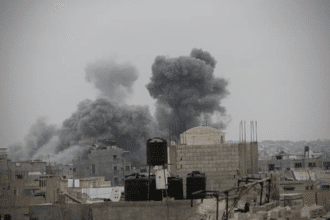Another battle of the intense military pressure-contested Han Kuang clashes between Taiwan and China is in its warming up, as Taiwan braces against the growing military pressure from China. The exercise started in 1984, and it has increased in its importance over the years. The military exercises held in Taiwan every year are a crucial element of the country’s defense policy, as the preparations on the island must be ready to defend against a Chinese invasion. Not only are the exercises aimed at bolstering the preparedness readiness of the military, but also establishing a message to Beijing, and also telling the Taiwanese that their defense potential is not empty rhetoric.
- What is Han Kuang, and why is this so Important?
- What occurs in the Taiwan Military Exercise?
- What is Taiwan doing to protect itself against Aggression by China?
- What is the reason behind the opposition of the military drills in Taiwan by China?
- What does this imply for the future defence policy of Taiwan?
- How is Taiwan Enhancing Civil Defense and Preparing Citizens for Emergencies?
- Concluding Remarks of Military Exercises in Taiwan
The Han Kuang drills this year will be the biggest and longest in the history of the exercise, as it will run a stable 10 days, or twice as long as the one it ran last year. All the more expedient are these exercises with the increasing military presence of China in the region and the increasingly aggressive attitude towards Taiwan.
What is Han Kuang, and why is this so Important?
Han Kuang is the biggest annual military exercise in Taiwan, s it is conducted to make sure that forces on the island are equipped to deal with any aggression, especially that of China, which considers Taiwan as a breakaway province. The official name is Han Kuang; it is a loose translation of Han Glory, as Taiwan was historically a province of the Republic of China (ROC). Though the official aim of the exercise is to train the defense of the island, it is also a great symbol of force to prevent any Chinese attempts at unification.
This also becomes a good way of sending a stern warning to Beijing in light of Taiwan’s growing isolation in the world arena; these military exercises are also used to communicate with Beijing. The drills demonstrate how Taiwan has been adherent to its sovereignty as it focuses more on defending itself without necessarily depending on foreign powers, especially the United States. Here is the link to our article on Military Cutbacks Savings
What occurs in the Taiwan Military Exercise?
The Han Kuang military exercises are extensive, after multi-dimensional activities that reenact different defense situations. These exercises usually have live-fire and non-live-fire drills and occur in international waters airspace, and land. This year, the exercises would demonstrate the newest technological developments in military equipment of Taiwan, and check the preparedness and the coordination of the military forces.
Live-fire drills are also among the most salient characteristics of this year, when exercise media included mobile rocket launchers, drones, and the latest locally developed missile systems. The exercise will also include the new purchase of the rocket systems by Taiwan from the United States. This system has earned the coverage that it has currently because of its long range of fire as opposed to the older system in use by the Taiwan military. HiHIMARS played a key role in the defense of Ukraine, and with this, a lot of might is added to the Taiwan defense system.
The Han Kuang exercises of this year would include 22,000 reservist soldiers, a figure which represents a growth of about 50 percent from last year. This drastic increase in participation portrays how Taiwan has added more emphasis on preparedness and its appreciation of the rising menace posed by China. On top of this, it is expected that the exercises will also challenge how Taiwan responds to surprise attacks, and the drills will remain unscripted so that they may simulate actual life combat better. Military analysts have commended this shift with a note that in the past, the exercises were usually criticized as more of a public relations exercise rather than readiness training.
What is Taiwan doing to protect itself against Aggression by China?
Taiwan has always had to deal with the threat of possible invasion by China. Since the year 1949, China has regarded Taiwan as a renegade province and has not disregarded the use of force to forcefully bring it under its area of control. The extent of military presence by China in the region has escalated over the years, requiring the issue about increased tension along the Taiwan Strait.
Taiwan has responded by making military hardware investments as well as restructuring its defense strategy. As the most notable part of the Taiwanese annual training exercises, Han Kuang is one of the most notable features of this transition.
Along with the military training, Taiwan has also changed its key strategic moves in recent years. Among the most crucial steps is the expansion of the compulsory military service. Previously, the Taiwanese military service was normally between one year, butt inn recent years the government has been considering increasing the duration to a maximum of two years. This transformation is considered a vital move towards strengthening the military might of Taiwan as well as making all willing citizens capable of protecting their own country.
Taiwan also invested more in asymmetric warfare capability, taking into consideration more mobile weapons, such as drones and superior missile technology. The systems are harder to counter an invading force and provide Taiwan with an advantage in its defense. This “porcupine” approach (named after the fact that this island wants to render itself hard to penetrate) is meant to give Taiwan a more difficult profile for Chinese troops to attack, in the event of an invasion.
Also, Taiwan is modernising its forces through indigenous technology. The island is already well advanced in developing its own submarines and missile defense system; this goes further into its self-defense position. Here is the link to our article on Troops Military Training
What is the reason behind the opposition of the military drills in Taiwan by China?
Beijing has time and again protested against the military exercises of Taiwan and believes that these are disguised provocations. Chinese leaders have reproached the Han Kuang exercises, terming them a show of Taiwan independence and a move to destabilize the status quo. The Ministry of National Defense of China even declared the exercise as a self-deceptive ploy to gather support for an independent state of Taiwan. He also voiced the position of China that Taiwan was an inseparable part of the Chinese territory and any separatist activity would be dealt decisively by the People huge Liberation Army (PLA).
Taiwan has not relented in its activities to defend itself, though China is opposed to such moves. Taiwan attaches importance to these military exercises, as they are crucial to their survival since it is aimed at sending a clear message to Beijing that they are not willing to cower down when Beijing applies pressure. Taiwan Strait has always been one region of confrontation, and as the military prowess of the two parties increases the region is becoming hyper sensitive.
What does this imply for the future defence policy of Taiwan?
These amendments of Han Kuang this year reflect bigger changes concerning the military defense strategy of Taiwan. Taiwan is also striving hard to improve its modernization and enhance its defense capabilities as it is facing the threat of more Chinese aggression. These initiatives have been in reaction to the internal and external forces.
Earlier, up to recent years, the confidence of the Taiwanese people in the military of the island had varied. A survey held last year recorded that only 47.5 of the Taiwanese population had confidence in the capacity of the country to protect itself. This quite low degree of assurance has instigated a desire to reform the Taiwanese military, whereby defense spending has been augmented, and there is a high emphasis on modernization.
Such a step toward modernization is not only taking place internally, but America has also been instrumental in encouraging Taiwan to strengthen its defense force. Under the Trump administration, there are consistent requests that Taiwan embark on spending more money on defense and modernizing its army against the increasing threat from China. Taiwan is aware that it cannot sell out its security in the hands of Washington, and as a matter of fact, the U.S policy towards Taiwan has been dubious at times. It has thus concentrated on the development of its indigenous systems and strategies of weaponry and defense to ensure better safety for its future.
The U.S. is also a major ally of Taiwan, especially as the U.S. continues to sell among the most sophisticated weapons to Taiwan because it intends to keep Taiwan independent.
How is Taiwan Enhancing Civil Defense and Preparing Citizens for Emergencies?
Besides training the military, Taiwan is working on improving its civil defense. Not only are Taiwan citizens used to doing the Han Kuang exercises to practice, but they also emergency drills concerning their civilians. Such exercises contain simulations of evacuations, air raid sirens, and a reaction to a possible attack. To warn the population, cellphone alerts will be given, which will inform them about possible risks, and the roads and transport hubs will be closed temporarily to compare the impact of a real emergency case.
Such a civil defense exercise has been regarded as a crucial component of Taiwan’s defense strategy because it would help ensure that the entire population is prepared to take action in case of a crisis. The government also intends to check whether the Taiwanese society is capable of resisting the effects of misinformation, especially the disinformation operations by the Beijing United Front Work.
Concluding Remarks of Military Exercises in Taiwan
Increased pressure from China has also obliged Taiwan to review its defense policies and enhance its military training. Taiwan Military Exercises, particularly the Han Kuang drills, play a crucial role in preparing both the military and civilian residents of Taiwan for the potential threat of an assault by China. With rising tensions in the Taiwan Strait, Taiwan is focusing on strengthening its defense infrastructure. By modernizing its military, empowering civil defense, and practicing readiness for any future threats, Taiwan aims to be fully prepared to respond to any situation that may arise.








